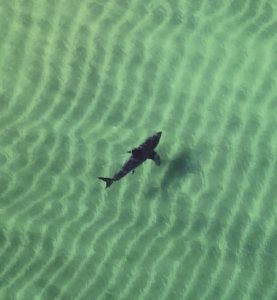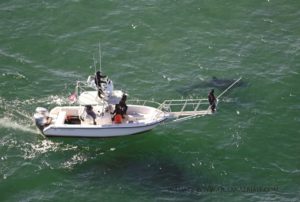On a hot summer day in 2008, Wayne Davis was flying his Citabria, a single-engine two-seat propeller plane, off the shores of Cape Cod, looking for bluefin tuna. With nearly 40 years behind him as a spotter pilot for commercial fishermen, Davis was thinking about retirement.
Then, as he passed over the breaking waves in front of Nauset Light Beach in Eastham, he saw a shark moving among a group of surfers.

“I wasn’t sure what type of shark it was, so I took a picture and kept flying,” Davis recalled. He believes that was the first aerial photo of a great white shark off Cape Cod — “and it landed me my dream retirement job,” he said.
Flying out of Chatham airport, Davis is now on the lookout for great whites for Greg Skomal of the Div. of Marine Fisheries (DMF) and researchers at the Atlantic White Shark Conservancy (AWSC).
A day in the office means flying over the swelling ocean waters, spotting great white sharks for a boat filled with eager shark researchers below. Once Davis spots a shark, he radios down to direct them to the shark for tagging.
“It’s a beautiful dance between the pilot in the sky and the captain on the water,” said AWSC researcher Megan Winton.
Davis grew up in a small fishing town in Rhode Island. He spent years fishing commercially before becoming a spotter pilot in 1972.
Since 2009, over 200 great white sharks have been tagged by Skomal and other researchers at AWSC. Most of them were first spotted from the air.
“The work we are doing in understanding the near-shore behavior of great whites is essential to both beach management and safety and conservation efforts to protect sharks,” said Marianne Long, AWSC education director.
“Great white sharks have an incredibly important role in our ecosystem,” said Long, “as an apex predator keeping our food chain in check.” That means hunting seals. And because seals feed on striped bass, bluefish, and baitfish, that’s how the great white sharks contribute to maintaining the balance of fish populations around Cape Cod.
Davis is one of many pilots — others include those flying privately, leading eco-tours, or spotting bluefin tuna — reporting shark sightings to beaches, where beach managers can make decisions over whether to close beaches to swimmers.

“A few years ago, I remember watching a great white zig-zagging through a group of surfers right off Nauset Light Beach, and I was circling overhead hoping they would notice me,” said Dan Kelly, a Delta pilot and part-time eco-tour pilot out of Chatham. “This was before we had a radio system in place to communicate with people on the beaches, so I just had to watch and hope that nothing bad was going to happen.”
On the East Coast, the job of the spotter pilot has a rich history going back to the 1960s, when swordfishermen first hired two or three pilots to find the fish for them.
By the ’70s and ’80s, 15 to 20 pilots from all around the New England coast — Martha’s Vineyard, Plymouth, New Hampshire, New Bedford, Nantucket, and Cape Cod — would make the long flight out to George’s Bank almost every day of the season, looking for swordfish.
And as the bluefin tuna fishery exploded during the mid to late ’80s, the skies followed.
“We used to get these advisories from Cape Approach warning incoming flights of ‘numerous fish-spotting pilots congesting the airspace,’ ” George Purmont, a long-time spotter pilot from Rhode Island, reminisced in his best air-traffic-control voice.
With more pilots monitoring active marine life, Purmont explained, scientists and pilots realized they could work together. But because there wasn’t much money to be made working for scientists, only a few pilots embraced the idea.
“There has always been a mistrust between commercial fishing and science,” Purmont said. “I’ve always felt that if you are capable of making a contribution to science, then you should.”
Purmont, now 75, started flying in 1972, and has logged 23,600 hours at the controls — equivalent to over 2.5 years.
He first reached across the fisherman-scientist divide in 1975, after reading a National Marine Fisheries report stating that there were only 2,000 giant bluefin tuna still in the Atlantic.
“I knew that wasn’t true, so I took a researcher up in the plane with me and showed him double that in one day,” Purmont said.
After that, Purmont understood the value of his position in the air. For the next three decades, he worked closely with Dr. Molly Lutcavage at the New England Aquarium, conducting aerial population and distribution studies for juvenile and giant bluefin tuna. He’s also worked for the state of Rhode Island counting the population of menhaden, and for Dr. Kara Dodge of the Woods Hole Oceanographic Institute, spotting leatherback sea turtles.
With a radio in one hand communicating with a fishing boat hundreds of feet below, and a camera in the other photographing and plotting fish schools for researchers back on land, Purmont became one of the earliest spotter pilots to aid the work of marine scientists in the Atlantic.
Today, in addition to the work done studying sharks, the Center for Coastal Studies (CCS) in Provincetown works with spotter pilots to conduct aerial surveys to aid in their research on marine mammals around Cape Cod — especially the highly endangered North Atlantic right whale.
Scientists and researchers from CCS fly down the middle of Cape Cod Bay and up the back side over 30 times a year, documenting individual right whales based on unique patterns on their backs.
“It’s an amazing tool to be able to research such a wide swath of the ocean from that top-down perspective,” said Amy James, flight coordinator for the Right Whale Ecology Program at CCS.
But not everyone appreciates the pilots zipping around the skies. Purmont remembers flying his plane off the East Coast looking for bluefin tuna when he suddenly got the feeling that he was being watched. His transponder lit up and he looked up to see an F-series jet flying above him — never a good sign.

Annoyed that the military jet was preventing him from doing his job spotting fish, he made tight turns that the faster jet couldn’t make. Eventually, he landed at a Long Island airport to sort out the problem.
Waiting there were black cars and men with pistols drawn, suspicious that Purmont — who’d been repeatedly crossing in and out of the Air Defense Identification Zone (ADIZ) — was a drug smuggler.
“I got out of my plane, looked at one of the guys and said, ‘You must be the third runner-up in the Frank Serpico lookalike contest,’ ” Purmont said. “They didn’t like that joke very much.”
He explained to the inquisitors that he had properly filed his flight plan, and went on to his next assignment.



